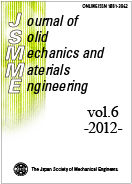All issues
Volume 6, Issue 9
Displaying 1-3 of 3 articles from this issue
- |<
- <
- 1
- >
- >|
Papers
-
Ryosuke MATSUZAKI, Naoki HIRAOKA, Akira TODOROKI, Yoshihiro MIZUTANI2012Volume 6Issue 9 Pages 935-949
Published: 2012
Released on J-STAGE: September 28, 2012
JOURNAL FREE ACCESSFrom a traffic safety point of view, there is an urgent need for intelligent tires which can optimize braking control by estimating the slip ratio and friction coefficient between a road surface and an automobile tire. The present study develops concurrent monitoring of frictional and vertical loads applied to the tires from the inner tire strain data for estimating the road/tire friction coefficient, which enables optimization of vehicle control and implementation of a road condition warning system. The tire strain is obtained using a three-dimensional digital image correlation method with a single wireless CCD camera attached to the wheel rim inside the tire. The procedures of the applied load estimation decompose the measured strain into the frictional and vertical strain components using their symmetrical and anti-symmetrical characteristics. Static tire rotation tests were carried out, and the applied loads were estimated from the inner tire surface strain distribution. Compared with the actual applied loads measured from strain gages attached to the experimental apparatus, it was confirmed that the vertical and frictional loads can be estimated independently with adequate accuracy.View full abstractDownload PDF (988K) -
Akira MAEKAWA, Tsuneo TAKAHASHI, Takashi TSUJI, Hiroshi SUZUKI, Atsush ...2012Volume 6Issue 9 Pages 950-964
Published: 2012
Released on J-STAGE: September 28, 2012
JOURNAL FREE ACCESSStress-free lattice spacing d0 has the most influence on reliability of neutron stress measurements made using an angle dispersive method. However, it is hard to evaluate the lattice spacing of welded structures and ductile materials such as stainless steel accurately. In this study, suitable measurement conditions for d0 of welded pipe joints of austenitic stainless steel were discussed. The d0 values derived from {311} and {111} reflections, which are often used in austenitic stainless steel for residual stress measurement, were examined. Comparison of the residual strains and stresses evaluated using the obtained d0 and the finite element analysis showed that the way the d0 values were chosen affected the measurement accuracy significantly. The stress measurement accuracy was remarkably improved when the {311} reflection was used and the proper d0 value was chosen in the respective neutron diffraction measurements. For instance, for the axial diffraction measurements using the {311} reflection, it was recommended that only the axial d0 value of the {311} reflection be used; the measurements using the {111} reflection were less accurate due to the large Young's modulus. Additionally, a lower diffraction angle was judged to be one of the factors leading to a decrease of the strain measurement accuracy.View full abstractDownload PDF (742K) -
Masahiro NISHIDA, Mitsuru AKAHORI, Fumiaki AIKAWA, Kayoko KUZUYA, Koic ...2012Volume 6Issue 9 Pages 965-974
Published: 2012
Released on J-STAGE: September 28, 2012
JOURNAL FREE ACCESSTargets made of aluminum alloy 5056 were subjected to hypervelocity impacts (HVI) from high-purity fused quartz (SiO2) projectiles at impact velocities of 0.8 to 3.4 km/s. The effect of the impact velocity on crater shape was examined experimentally, and the Vickers hardness was measured near the crater wall. These results were compared with the results for other brittle projectiles, such as soda-lime glass spheres and NaCl projectiles. The ratio of the crater depth to the crater diameter, expressed as a function of the impact velocity, showed anomalous humps below 2.2 km/s and a steady state above 2.2 km/s. Humps in this ratio were originally observed by Baker, Bernhard and Hörz in 1995. In 2004, Valerio-Flores et al. showed that the steady state value of this ratio varied between 0.5 and 1.2 for projectile densities ranging from 2.3 to 15 g/cm3. Our results were good agreement with these results. The relationships among projectile fragmentation, phase transition, and crater formation were discussed.View full abstractDownload PDF (1779K)
- |<
- <
- 1
- >
- >|
